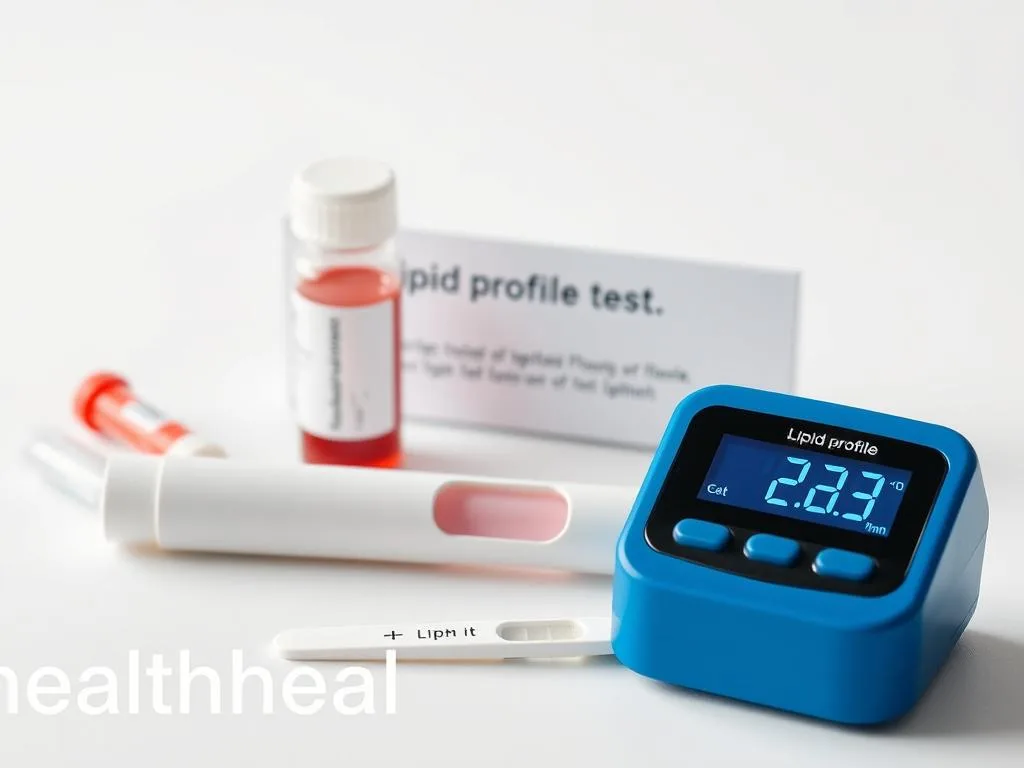Did you know nearly 40% of American adults have high cholesterol? This can harm your heart health. Keeping your lipid profile healthy is key to avoiding heart disease and stroke. In this article, we’ll show you how to naturally lower your lipid profile with simple diet and lifestyle changes.
Your lipid profile measures cholesterol and triglycerides in your blood. Knowing these numbers helps you make better food choices and lifestyle changes. These steps not only improve your lipid profile but also boost your heart health for the long term.
Key Takeaways
- Nearly 40% of American adults have high cholesterol levels.
- A healthy lipid profile is vital for preventing heart disease and stroke.
- You can lower lipid profile naturally with diet and lifestyle changes.
- Understanding cholesterol levels and triglycerides is key to improving heart health.
- Making proactive changes can lead to long-term benefits for your cardiovascular system.
Understanding Your Lipid Profile
Your lipid profile is a key blood test that checks your cholesterol and triglycerides. It looks at low-density lipoprotein (LDL), high-density lipoprotein (HDL), very-low-density lipoprotein (VLDL), and total cholesterol. Knowing these levels helps you see what’s healthy for you.
LDL, or “bad” cholesterol, can clog your arteries. On the other hand, HDL, or “good” cholesterol, helps clean your arteries. This makes HDL important for heart health.
Let’s look at the main cholesterol types in a lipid profile:
| Cholesterol Type | Description | Health Implications |
|---|---|---|
| LDL (Low-Density Lipoprotein) | Often termed “bad” cholesterol, it can lead to artery blockages. | Higher levels increase the risk of heart disease. |
| HDL (High-Density Lipoprotein) | Known as “good” cholesterol, it helps remove cholesterol from the blood. | Higher levels are linked to a lower risk of heart disease. |
| VLDL (Very-Low-Density Lipoprotein) | Primarily carries triglycerides in the blood. | High levels can lead to plaque buildup in arteries. |
| Total Cholesterol | The sum of all cholesterol types in the bloodstream. | High levels may necessitate lifestyle changes. |
Understanding your lipid profile helps you make better choices for your health. By knowing what each part means, you can pick the right foods and activities. Regular tests keep you updated on your cholesterol and lipid levels.
The Importance of a Healthy Lipid Profile
Keeping your lipid profile healthy is key for your heart health and overall well-being. High cholesterol, like LDL, can increase the risk of heart disease, heart attacks, and strokes. It’s important to know the parts of your lipid profile to manage your health well.
Monitoring your lipid profile is more than just immediate health. It helps you make long-term health choices. High levels of HDL protect your heart, keeping your cardiovascular system safe.
Understanding the importance of balanced lipid levels helps you take control of your health. Regular tests and awareness lead to better health outcomes. This means a more vibrant and active life for you.
How to Lower Lipid Profile Naturally
Getting a healthier lipid profile can greatly boost your well-being. There are many ways to naturally lower your lipid profile. By using natural methods to lower cholesterol, you can see significant health improvements. Here are some practical tips to manage your cholesterol and reduce triglycerides.
Natural Ways to Lower Cholesterol
Adding certain foods to your diet can make a big difference. Focus on foods rich in soluble fiber, such as:
- Oats
- Barley
- Beans and legumes
- Fruits like apples and pears
These foods help absorb cholesterol, improving your lipid profile. Also, include healthy fats from:
- Avocados
- Nuts
- Olive oil
These can also help your cholesterol levels. Always check food labels for low trans fats and added sugars.
Strategies to Reduce Triglycerides
To lower triglycerides, make some dietary changes. Start by cutting down on:
- Sugary foods and drinks
- Refined carbs like white bread and pastries
Adding omega-3 fatty acids to your meals can also help. Foods rich in omega-3 include:
- Fatty fish like salmon and mackerel
- Flaxseeds and chia seeds
- Walnuts
By sticking to these strategies, you can naturally lower your lipid profile.
| Food Type | Benefits |
|---|---|
| Oats | Rich in soluble fiber, helps reduce cholesterol |
| Fatty Fish | High in omega-3, lowers triglyceride levels |
| Avocados | Healthy fats, beneficial for heart health |
| Beans | High in fiber, assists in cholesterol management |
Essential Foods for a Healthy Lipid Profile
To keep your lipid profile healthy, choose your food wisely. A diet rich in healthy fats and fruits and vegetables is key. This mix helps improve your heart health.
Healthy Fats to Include in Your Diet
Healthy fats are vital for controlling cholesterol. Olive oil, avocados, nuts, and fatty fish like salmon are great. They lower bad cholesterol and boost heart health. Swap out saturated and trans fats for these better options.
Fruits and Vegetables for Optimal Heart Health
Fruits and vegetables are essential for a healthy heart. They’re full of antioxidants that fight inflammation and protect blood vessels. Some top picks include:
- Blueberries
- Spinach
- Broccoli
- Oranges
- Tomatoes
Eating a variety of these foods daily boosts your nutrient intake. This supports your heart and keeps your lipid panel in check.
| Food | Type of Healthy Fat | Heart Health Benefits |
|---|---|---|
| Olive Oil | Monounsaturated | Lowers bad cholesterol |
| Avocado | Monounsaturated | Boosts heart health |
| Nuts | Polyunsaturated | Improves cholesterol levels |
| Fatty Fish | Omega-3 Fatty Acids | Reduces triglycerides |
| Berries | Antioxidants | Combat inflammation |
Creating a Balanced Diet for Lipid Profile Improvement
To improve your lipid profile, a balanced diet is key. It focuses on whole foods that are good for your heart. Include foods that help lower cholesterol and triglycerides.
Here are important parts of a balanced diet:
- Whole Grains: Foods like oats, quinoa, and brown rice are high in fiber. This can help lower cholesterol.
- Fruits and Vegetables: Choose a variety of colors to get enough vitamins, minerals, and antioxidants.
- Healthy Fats: Add avocados, nuts, seeds, and olive oil. They can help improve your lipid levels.
- Lean Proteins: Eat chicken, turkey, and fish. Fatty fish like salmon and mackerel have omega-3s, which are good for your heart.
How much you eat matters a lot. Eat mindfully to control portions and boost nutrition. Meal plans that focus on these foods can help you stay on track.
Adding these habits to your daily routine can improve your lipids over time. Make sure your diet is varied and balanced. This way, you’ll enjoy eating while keeping your lipid profile in check.
Exercise for Lipid Profile: The Best Routines
Regular exercise is key to managing your lipid panel Both cardio exercises and strength training are great for your health. They help lower bad cholesterol and triglycerides while boosting good cholesterol. A balanced exercise routine is good for your heart and overall health.
Cardio Exercises to Boost Heart Health
Cardio exercises are vital for better heart health. Activities like walking, running, cycling, and swimming burn calories and improve heart function. Here’s a sample weekly cardio plan:
- 30 minutes of brisk walking at least five times a week
- 15-20 minutes of jogging or running three times a week
- 30-45 minutes of cycling or swimming two to three times a week
Strength Training’s Role in Lowering Cholesterol
Strength training does more than build muscle. It boosts metabolism, helping lower bad cholesterol. Include strength training exercises two to three times a week, focusing on big muscle groups. Try these exercises:
- Deadlifts
- Bench press or push-ups
- Squats or lunges
- Rows or pull-ups
Mixing cardio exercises with strength training is best for your lipid panel. Make sure your routine includes both types of exercise. Don’t forget to rest and recover well for the best results.
| Exercise Type | Frequency | Benefits |
|---|---|---|
| Cardio Exercises | 5 times/week | Burns calories, lowers triglycerides |
| Strength Training | 2-3 times/week | Increases metabolism, boosts HDL |
Natural Remedies for Lipid Profile Management
Managing your lipid profile can benefit from natural remedies. Adding certain supplements to your routine can improve your cholesterol levels. For example, omega-3 fatty acids in fish oil can lower triglycerides and boost heart health.
Plant sterols are another good choice. They block cholesterol absorption in the intestines. Soluble fiber in foods like oats and beans also helps lower LDL cholesterol levels.
Herbal remedies can help with lipid profile management too. Garlic is known for lowering cholesterol, and green tea is good for heart health because of its antioxidants.
Before starting any new natural remedies or supplements, talk to a healthcare professional. They can make sure any changes are safe and right for you.
Monitoring Your Lipid Profile: When to Get Tested
Regular testing is key to managing your lipid profile. It’s advised to start testing at age 20, every four to six years. If you have a family history of heart disease, you might need to test more often.
Watching your diet and exercise is part of health monitoring. Knowing your risk factors helps decide when to test. Always talk to your doctor to set the right testing schedule for you.
| Age | Testing Frequency | Notes |
|---|---|---|
| 20-45 | Every 4-6 years | Consult with your provider for risk factors. |
| 46-55 | Every 3-5 years | Increased risk may require more frequent testing. |
| 56 and above | Every 1-3 years | Monitor closely if other health issues are present. |
Following these testing guidelines helps keep your heart healthy. Being proactive with health monitoring improves your lipid profile and overall well-being.
Maintaining Healthy Cholesterol Levels Long-Term
To keep your cholesterol healthy, you need to make long-term strategies a part of your life. Eating heart-healthy foods, managing stress, and staying active are key. Eating right and choosing whole foods over processed ones is important.
Being active every day helps control cholesterol and improves heart health. Try to do at least 150 minutes of moderate exercise weekly. This can help lower bad cholesterol and raise good cholesterol.
It’s also important to check your cholesterol levels often. This lets you make changes as needed. Quitting smoking and drinking less alcohol are big steps towards better health. Remember, keeping your cholesterol healthy takes ongoing effort and dedication.
Conclusion
You now have a complete guide to fixing your lipid profile naturally. This includes diet and lifestyle changes. Knowing how cholesterol and triglycerides work in your body helps you improve your heart health.
Every change you make, like what you eat or how much you exercise, helps a lot. These efforts add up to better your lipid profile.
Keeping your cholesterol levels healthy is a long-term effort. Regular checks and learning about your lipid profile help you make better choices. These choices not only help your heart but also improve your life overall.
Remember, being consistent is key. By making these changes a part of your daily life, you’re investing in a healthier future. Keep learning and practicing healthy habits to support your heart health and lipid profile.
FAQ
What is a lipid profile test?
A lipid profile test checks your blood for different types of cholesterol and triglycerides. It looks at LDL (bad cholesterol), HDL (good cholesterol), and total cholesterol. This helps figure out your risk for heart disease.
How can I lower my lipid panel naturally?
To lower your lipid profile naturally, eat a diet full of soluble fiber, healthy fats, and omega-3 fatty acids. Also, stay active with regular exercise. Foods like oats, legumes, avocados, and fatty fish are great choices.
What are some healthy fats to include in my diet?
Healthy fats are found in olive oil, nuts (like almonds and walnuts), avocados, and fatty fish (such as salmon and mackerel). These fats can improve your cholesterol levels when eaten in moderation.
How often should I get a lipid panel test?
Start lipid panel tests at age 20 and do them every 4 to 6 years. Or, as your healthcare provider advises, if you have heart disease risk factors.
What role does exercise play in managing my lipid panel ?
Exercise is key in managing your lipid panel. It lowers LDL and triglycerides while raising HDL. Aim for 150 minutes of moderate-intensity aerobic exercise weekly.
What natural remedies can help improve my lipid panel?
Natural remedies like omega-3 fatty acids, plant sterols, and soluble fiber can help. Garlic and green tea also have benefits. Always talk to a healthcare professional before starting new supplements.
Can my diet alone affect my cholesterol levels?
Yes, your diet greatly affects your cholesterol levels. Eating heart-healthy foods like fruits, vegetables, whole grains, and lean proteins helps. Avoid sugar, saturated fats, and refined carbs.
Are there specific fruits and vegetables that improve heart health?
Yes! Berries, apples, oranges, leafy greens, broccoli, and bell peppers are full of antioxidants and nutrients. They help reduce inflammation and support heart health.






